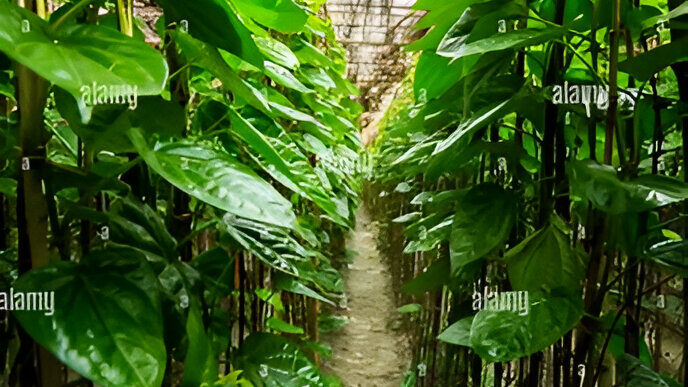Paan: Its Origin and Influence in India
I bet everyone has heard this song: “Khaike Paan Banaraswala, khul jaye band akal ka tala” from the 1978 movie Don, starring Amitabh Bachchan. This iconic song highlights the widespread popularity of paan in India. Want to know more about this beloved treat? Let’s dive into its origins and influence in Indian culture.
Origins of Paan
Paan, a traditional Indian preparation, consists of betel leaf filled with various ingredients such as areca nut, slaked lime, and often sweet or savory additives. Its history dates back thousands of years, with references found in ancient Indian texts like the Vedas and the Mahabharata. Originally consumed for its digestive and refreshing properties, paan quickly became embedded in the social and cultural fabric of India.
Influence of Paan in India
Paan is not just a treat; it’s a cultural phenomenon with deep-rooted significance across India. Here are some key aspects of its influence:
- Cultural Significance: Paan is often offered as a gesture of hospitality and respect in Indian households. It plays a crucial role in rituals, weddings, and festivals, symbolizing prosperity and good fortune.
- Social Interaction: Small paan vendors, known as paanwalas, are ubiquitous across India. These stalls serve as social hubs where people gather, converse, and enjoy paan together, fostering community bonds.
- Culinary Diversity: The preparation of paan varies by region, with each area adding its unique twist. From the spicy Varanasi paan to the sweet Kolkata meetha paan, the diversity of flavors caters to a wide range of tastes.
Betel Leaf Economics: The Green Gold of Odisha
Betel leaf cultivation is a high-income agricultural activity thriving in the coastal districts of Odisha like Jagatsinghpur, Kendrapra, Balasore, Puri, Cuttack, and Ganjam. This green gold significantly impacts the local economy, especially in the coastal villages where it is a major source of livelihood.
Betel Leaf Cultivation in Jagatsinghpur
Three Gram Panchayats (GP) of Jagatsinghpur—Dhinkia, Nuagaon, and Gadakujanga—have been in the spotlight for the last decade and a half due to their opposition to proposed steel projects. These areas are also among the top hubs of betel leaf cultivation in Odisha and across the country. Near the port of Paradip, these villages possess the most suitable soil quality, comprising fine sand and moisture, ideal for betel vineyards.
Over 80% of the 20,000 people living in the eight villages under the three GPs depend on betel leaf cultivation, either directly or indirectly. This cash crop, known for its high quality, is famous as ‘Banarasi Paan’ and enjoys substantial demand across India and abroad.

Economic Impact
Betel leaf cultivation significantly contributes to the local economy in several ways:
- Employment Generation: The cultivation process involves various activities such as planting, nurturing, harvesting, and marketing, providing employment to a large portion of the population.
- High Income: Compared to other agricultural activities, betel leaf farming is more profitable, offering better income opportunities for farmers.
- Market Demand: The high demand for ‘Banarasi Paan’ ensures steady income for cultivators. The leaves are sold not only in local markets but also exported to different parts of India and abroad, fetching premium prices.
- Sustainable Agriculture: Betel leaf farming is considered sustainable as it requires less water compared to other crops and fits well within the ecological conditions of the coastal regions.
The Health Benefits of Paan: Beyond the Banarasi Charm
Well, who knew that the famous ‘Paan Banarasi Wala’ is not actually from Banaras but from Odisha? Regardless of its origins, paan is not only a beloved treat but also offers several health benefits. Let’s dive into the health advantages of paan and its key base ingredients: slaked lime, sauf, and kattha.
Health Benefits of Paan
Paan, when consumed in moderation and prepared with natural ingredients, can provide several health benefits:
- Digestive Aid: Paan is traditionally consumed after meals due to its digestive properties. The combination of betel leaf and other ingredients stimulates the production of saliva and digestive juices, aiding in digestion.
- Oral Health: Betel leaves contain compounds with antimicrobial properties, which can help maintain oral hygiene by reducing bad breath and preventing cavities.
- Antioxidant Properties: Betel leaves are rich in antioxidants, which help in neutralizing free radicals and protecting the body from oxidative stress.
- Respiratory Health: Some ingredients used in paan, such as sauf (fennel seeds), are known to have expectorant properties, which can help in clearing mucus and relieving respiratory conditions.

Key Ingredients and Their Benefits
- Slaked Lime (Chuna):
- Calcium Source: Slaked lime is a rich source of calcium, which is essential for maintaining healthy bones and teeth.
- Digestive Aid: It aids in the digestive process by stimulating the production of digestive enzymes.
- Sauf (Fennel Seeds):
- Digestive Benefits: Fennel seeds are known for their carminative properties, which help in reducing bloating and gas. They also promote the secretion of digestive juices.
- Antioxidant and Anti-inflammatory: Sauf contains antioxidants and has anti-inflammatory properties that contribute to overall health.
- Kattha (Catechu):
- Astringent Properties: Kattha has astringent properties, which help in tightening tissues and reducing inflammation.
- Oral Health: It is often used in traditional medicine for its benefits in treating oral conditions like ulcers and gum diseases.
Conclusion: Wrapping Up the World of Paan
As we close our exploration of paan, we’ve journeyed from its origins in Odisha to its significant role in local economies, especially in coastal villages. We’ve delved into the health benefits of paan, highlighting its key ingredients such as slaked lime, sauf, and kattha. Paan is more than just a cultural icon; it’s a testament to India’s rich agricultural heritage and culinary diversity.
Looking Ahead
Though we’ve covered much about paan, there’s always more to explore in the vast realm of Indian cuisine. Be sure to check out our previous articles to catch up on any you might have missed, and stay tuned for more exciting topics in the future.
Follow for more Tales and Tadka – Until next time.



